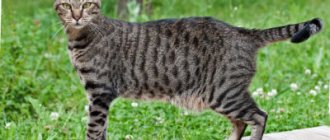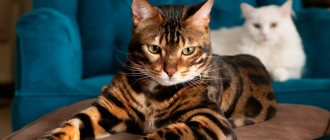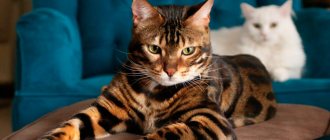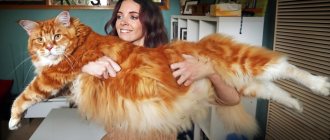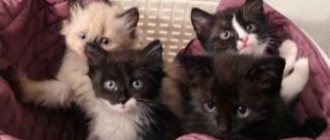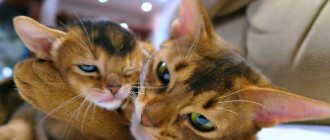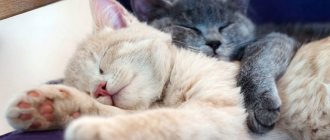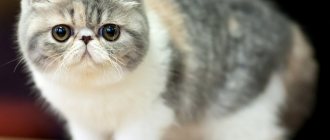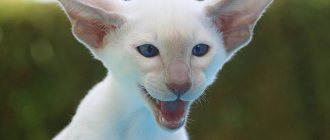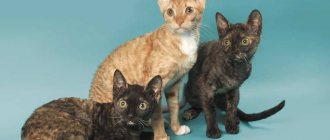SpongeBob
In 2012, the Guinness Book of Records entered a new record - the fattest cat in the world was determined. It turned out to be a red-haired pet with an interesting nickname SpongeBob. Its weight is 15.5 kg, which is approximately equal to the weight of a four-year-old baby.
The cat ended up in a New York cattery, where he surprised the entire staff with his weight. The animal underwent a full examination to exclude the possibility of diseases. And it turned out that the cat was completely healthy.
True, the nursery staff are sure that excess weight is not the norm for a 9-year-old cat. And they try to help him get rid of the extra pounds through a special diet and special exercises. Veterinarians expect that losing excess weight will allow the cat to move normally.
Prevention
Preventing obesity in cats is quite simple - there are a few simple rules to follow:
- Do not overfeed! And also monitor the quality of the feed. Don't skimp on it. Do not mix or alternate “drying” and “natural”. You can often determine by eye how much food is normal for a cat and how much is not. And even if your plump pet furry demands his portion - be adamant and feed on schedule. Week 2 and he capitulates.
- Don't limit your pet's play. Provide sufficient physical activity, because the cat is a predator by nature and must run to feed itself now. Do not deprive the mustache of this opportunity. They put food in his bowl at the first “meow,” so where does the energy go? Play more often, let the cat run, otherwise he will quickly become fat.
- Change your diet. If your mustache is castrated/sterilized, then be sure to review the diet and choose a special diet. And be sure to play with your furry four-legged friend more often.
Well-fed Elvis
Another fat cat lives in Germany. His name is Elvis and he weighs 17.5 kg. Unlike some well-fed, but luckier relatives, the German fatty has health problems. He was diagnosed with diabetes, which developed due to obesity. The pet moves very little, because after a few steps it becomes difficult for him to bear such a large weight.
The cat's owners are currently trying their best to help him cope with excess weight. Elvis is given insulin injections twice a day and has also been prescribed a special diet to lose weight. They say that with the help of thoughtful nutrition, the gray and white cat got rid of 1 kilogram and continues to lose weight.
Now Elvis is considered “the fattest cat in Germany.” But according to the volunteers who took care of the animal’s health, this cat may receive the title of “the fattest cat in the world.” His weight, even after losing weight, remains greater than that of the cat, which is now recorded as “the fattest in the world” in the Guinness Book of Records.
Weight standards for cats
Overweight is common in cats, just as it is in people. Multiple causes of this disease can lead to various diseases and pathologies, so owners of furry pets need to monitor their nutrition and health.
Obesity in a cat
What does a cat’s body weight depend on:
- Breed. It is worth noting that each member of the cat family has its own weight norm. Large breeds such as the Maine Coon weigh much more than their miniature counterparts (Persians, Sphynxes, etc.).
- Floor. Most often, a boy, for example a British breed, has a larger mass than a girl of the same breed. Males are generally larger than cats. The difference can be about 2 kg.
- Castration and sterilization. After these operations, the animal’s hormonal background changes, and therefore weight begins to increase.
- Diseases. Obesity can be a consequence of any disease or dysfunction of internal organs.
- Age. Young cats are smaller than older cats because they are more active and healthy.
- Constitution. The physique of cats is also individual: some are more muscular, while others are thin and graceful.
- Nutrition. Pets should be fed a balanced and high-quality diet.
- Lifestyle. Sedentary animals always weigh more than active ones.
Important! The most common breeds that are prone to gaining excess weight are Sphynxes, Britons, Persians, Exotics and Burmese. Owners of such breeds must be careful to prevent them from becoming obese.
How can you determine if your pet’s weight is normal? A fat cat has a noticeably large belly (apron), no waist, and a large muzzle. The ribs of such animals cannot be felt under the fat layer. A cat with a normal weight is active, he has a proportional body with a waist, the bones are palpable, but do not stick out.
Comparison of a healthy cat and an obese cat
The average weight for newborn kittens is 70-140 g. Gradually, they begin to add 15 g per day, and then 100 g by 2 months. Plump kittens are quite rare, as they are very active and their metabolism is still fast.
In a year, a cat will gain weight, which will remain there for many years to come if you monitor its health. To understand the norm of weight, we can take several fairly common breeds as an example. By the first year of life, a large representative of the Maine Coon reaches from 5.3 kg to 8.8 kg, and a representative - from 4.5 to 8.3 kg. Small British cats weigh about 2.5 - 4.6 kg, and male cats - 4.5 - 7 kg. The average-built Siberian breed weighs from 4.5 to 7 kg, regardless of gender.
Note! It is not worth making final conclusions about the weight of an animal based on the established average if it looks healthy and well-built. A cat that is too thin and has protruding bones cannot be healthy either. Diseases can also develop from malnutrition, as well as from overeating.
Handsome Pikkis
The next representative of fat cats lives in Helsinki. He may well be the next contender for the title of fattest. His name is Bond, but his owners prefer to call him by his charming nickname Pikkis, which literally translates as Baby.
The cat weighs 16 kg and is 120 cm long, which is not at all surprising, since the animal belongs to the Maine Coon breed. This breed is considered the largest in the world, but even for its representatives, a weight of 16 kg is rare.
What other large breeds exist?
As we have already found out earlier, there are more than a dozen large breeds of the cat family in the world intended for home keeping. Let's look at a few more representatives of big cats.
British
Among these pets there are short-haired and long-haired individuals. Males weigh up to 10 kg, and females - from 5 to 7. Distinctive features: solid color (gray-blue, black and chocolate), silver tabby, as well as a love of solitude and an independent character.
Siberian
They were found everywhere in the Russian Empire and are still popular in Russia. They have different colors and semi-long hair. The weight of adult cats is about 6-9 kg, females weigh a little less - 5-7 kg.
Turkish van
It is considered an aboriginal representative of the oldest domestic cats. They are also recognized as one of the largest predators of the cat family. The weight of an adult cat can be 8-10 kg, and the body length can be from 90 cm to 1 m 20 cm. The traditional color is red-chestnut. The Turkish van looks noble, but its character is contradictory - sometimes capricious, sometimes affectionate.
Pixie bob
Amazing creatures are very reminiscent of lynx, because this was the purpose of their breeding. They have a neat short tail and an interesting color. Average weight – 5-8 kg. They have a meek and gentle disposition.
Norwegian forest
Distributed in Northern Europe. Quite a large animal weighing up to 9.5 kg. The fur is thick and long, and there are tassels on the ears. The character of the purebred individual is freedom-loving, but friendly, he loves to hunt and play.
Of course, the Savannah and Maine Coon are considered the largest cats, but there are several other breeds that are not far behind the graceful “giants.” Just remember that not only the size of the animal, but also its behavior, health and character depends on the breed.
Fat Thule from Denmark
The leader in terms of weight today can be called the cat Tulle. A fat cat weighing 19.5 kg is not able to care for itself. Of course, a pet does not catch mice; it is not at all interested in love affairs. But this is not surprising at such a weight.
The cat owes such a large body weight to its lifestyle. According to the owners, Tulle is very lazy. His favorite pastime is relaxing near the TV. In addition, the ginger cat loves to eat. So far there is no talk of any serious illnesses in the six-year-old cat, but his impressive weight is very worrying for his owners. They are going to send him to courses where they offer low-calorie diets and exercises to lose weight.
Fat pets rarely make it onto the pages of the Guinness Book of Records. It is possible to determine the fattest cat only by applications submitted by the owners. But not all cat owners think about having their pet’s name appear on the pages of the famous Book of Records. Therefore, it is likely that the fattest cat lives next door, but we don’t know anything about it.
Savannah
This breed resembles a wild serval. What makes them unique is their spotted coat. The color is golden or beige, with a lighter undercoat. The silhouette is thin. The legs are muscular, the hind legs are slightly longer than the front ones. The tail is wide, not very long. The Savannah's neck is proportional to the length of the back, slender. The head is triangular and rather small compared to the rest of the body. The ears are set high on the head and large in relation to it. They stand upright, wide, narrow, ending in slightly rounded spines. Medium-sized eyes are set deep, the standard allows all colors of the iris.
Also typical of the Savannah breed are tear-shaped markings around the eyes, which give these cats an exotic, cheetah-like appearance. Savannah is very friendly, playful and sociable. They have a strong need to move and are usually very active, requiring a variety of activities. Therefore, they should be given either different toys or, for example, the company of a second cat. They are also very patient with children.
Savannah can be stubborn and often act on her own. However, they are very attached to their guardian. Due to its temperament, the Savannah is not recommended for first-time owners.
| Savannah breed size chart | |||
| Height at withers (cm) | Body length | Weight, kg) | |
| Cat | 60 | 120 | 20 |
| Cat | 50 | 100 | 15 |
| Kitten (3 months) | 3 |
Savannah should be fed raw meat. But it’s better to freeze it. But it is better to limit cereals and dairy products. At the age of 3 months, the animal can begin to be trained (approximately like a dog).
